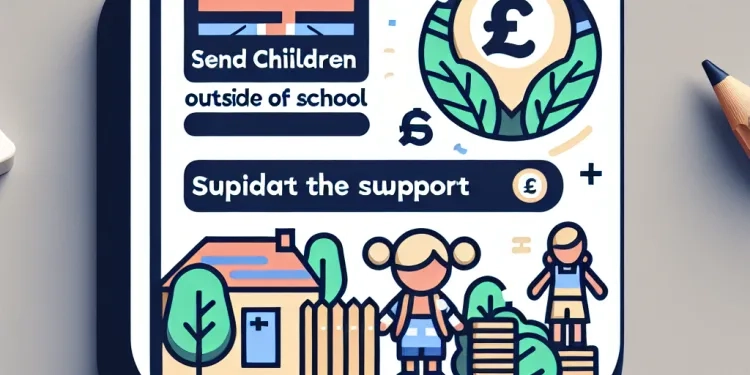
Find Help
More Items From Ergsy search
-

How can schools create an inclusive environment for SEND children?
Relevance: 100%
-

Do SEND children attend mainstream schools?
Relevance: 75%
-

What support is available for SEND children in schools?
Relevance: 69%
-

What are SEND children?
Relevance: 68%
-

Who are SEND children?
Relevance: 67%
-

Can SEND children access extracurricular activities?
Relevance: 64%
-

Are there specific laws governing SEND in schools?
Relevance: 58%
-

What support is available outside of school for SEND children?
Relevance: 57%
-

What role do teachers play in supporting SEND children?
Relevance: 56%
-

How is progress measured for SEND children?
Relevance: 49%
-

Can children with disabilities access school meals?
Relevance: 46%
-

What are some common misconceptions about SEND?
Relevance: 44%
-

What does SEND stand for?
Relevance: 43%
-

How are parents involved in the SEND process?
Relevance: 42%
-

What is the SENCO's role in a school?
Relevance: 41%
-

How do funding and resources affect SEND support?
Relevance: 40%
-

Can SEND status change over time?
Relevance: 39%
-

Who is responsible for assessing SEND needs?
Relevance: 38%
-

What are some common types of SEND?
Relevance: 36%
-

Are there educational components to the school meal program?
Relevance: 32%
-

See4School
Relevance: 31%
-

Are school meals free for all students in the UK?
Relevance: 31%
-

How are food allergies managed in UK schools?
Relevance: 30%
-

How do banking fees impact financial inclusion?
Relevance: 30%
-

What is the work environment like at the National Trust?
Relevance: 29%
-

How are school meals provided in the UK?
Relevance: 29%
-

Are vegetarian or vegan options available in UK school meals?
Relevance: 29%
-

Are school meals inspected for quality and standards?
Relevance: 29%
-

What role does the environment play in ADHD?
Relevance: 29%
-

How are special dietary requirements catered for in school meals?
Relevance: 28%
-

Dyspraxia Children: How to Help
Relevance: 28%
-

Who is responsible for providing school meals in the UK?
Relevance: 27%
-

What is the purpose of providing school meals in the UK?
Relevance: 27%
-

What is the average cost of a school meal in the UK?
Relevance: 27%
-

Understanding Mental Health in Children
Relevance: 27%
-

Calls to Ban Vapes Near School Grounds Gain Momentum
Relevance: 26%
-

How can parents advocate for their SEND child?
Relevance: 26%
-

Are there any initiatives to reduce food waste in schools?
Relevance: 26%
-

What criteria must be met for a child to be eligible for free school meals?
Relevance: 26%
-

How do I send books or magazines?
Relevance: 26%
Understanding SEND
Special Educational Needs and Disabilities (SEND) encompasses a wide range of needs that children may have during their educational journey. In the UK, it is important for schools to provide an inclusive environment where SEND children can thrive alongside their peers. This involves creating an educational setting that is accommodating, understanding, and supportive of various learning and physical disabilities, as well as mental health issues.
Creating Inclusive Policies
One of the primary steps schools can take is to craft comprehensive inclusive policies. These policies should outline the school's commitment to inclusivity and detail the support available for SEND students. This includes clear guidelines on how the school identifies and assesses SEND needs, how it involves parents and students in the process, and how it ensures adjustments are made to support individual needs. Regular reviews of these policies are essential to ensure they remain effective and up-to-date with current legislation and best practices.
Teacher Training and Awareness
Training staff is critical in fostering an inclusive environment. Teachers and other staff members should be equipped with the skills and knowledge necessary to support SEND students effectively. This includes understanding different types of SEND needs, learning how to adjust teaching methods, and being able to use assistive technologies when necessary. Regular training sessions can help keep staff informed about new strategies and tools available for supporting SEND students.
Adapting the Curriculum
Adapting the curriculum to meet the needs of SEND students is another key component. This may involve differentiating instruction, providing more practical learning opportunities, or incorporating multi-sensory teaching methods. Schools should aim to deliver a flexible curriculum that accommodates diverse learning styles, ensuring that SEND students can engage with the material and demonstrate their understanding effectively.
Building a Supportive Community
A supportive school community involves everyone from teachers and students to administrative staff and parents working together to create an inclusive atmosphere. Encouraging open communication among all parties helps to foster understanding and acceptance. Schools can arrange workshops and awareness campaigns to educate the community about SEND needs and promote inclusivity across the board.
Providing Resources and Facilities
Ensuring adequate resources and facilities to support SEND students is also crucial. Schools should provide access to specialized equipment or learning aids tailored to different needs. In addition, physical adaptations to the school environment, like wheelchair ramps, accessible classrooms, and sensory rooms, can significantly impact the learning experience of SEND pupils. Assessing the school environment and making necessary adjustments demonstrates a commitment to inclusivity and ensures all students have equal opportunities to succeed.
Understanding SEND
SEND stands for Special Educational Needs and Disabilities. This means some children need extra help at school. In the UK, schools make sure they are places where all children, including those with SEND, can learn happily together. Schools try to be kind, understanding, and helpful. They help with different kinds of learning, movement, or even feelings and emotions that might be tricky for some children.
Creating Inclusive Policies
Schools make "inclusive policies" to show they care about SEND students. These are like school rules that explain how they will help children with SEND. They plan how to find out what help a child needs, and they talk with parents and students to decide what to do. Schools must check these plans often, to make sure they are the best they can be.
Teacher Training and Awareness
It is important that teachers know how to help children with SEND. Teachers should know about different SEND needs, how to change their lessons, and how to use special equipment to help. Schools can teach teachers new ways to help and tell them about new tools that might be useful for SEND students.
Adapting the Curriculum
Changing lessons to help children with SEND is important. This might mean making lessons easier to understand, giving hands-on activities, or using many senses to learn (like seeing, hearing, and touching). Schools try to make lessons flexible so all children can learn and show what they know in the best way for them.
Building a Supportive Community
Everyone in the school, like teachers, parents, and students, should work together to help children with SEND. Talking to each other helps everyone understand and accept each other. Schools can hold workshops and campaigns to teach the community about SEND and how to include everyone.
Providing Resources and Facilities
Schools should have the right tools and spaces to help SEND children. This might be special devices or learning aids. It also means making the school easier to move around, like having ramps for wheelchairs and special rooms for quiet time. Checking and changing the school helps all children learn better and shows they care about everyone having the same chances to do well.
Frequently Asked Questions
What does SEND stand for?
SEND stands for Special Educational Needs and Disabilities.
Why is it important to create an inclusive environment for SEND children?
An inclusive environment ensures that all children, including those with SEND, have equal opportunities to learn, grow, and participate fully in school life.
How can schools identify the needs of SEND children?
Schools can identify the needs of SEND children through assessments, observations, feedback from parents and teachers, and working with specialists.
What role does teacher training play in inclusion?
Teacher training equips educators with the skills and knowledge to address the diverse needs of SEND students and to implement inclusive practices in the classroom.
How can schools adapt the curriculum for SEND students?
Schools can adapt the curriculum by differentiating instruction, using assistive technologies, and providing additional support tailored to the needs of SEND students.
What are Individualized Education Plans (IEPs)?
IEPs are customized plans designed to meet the unique educational needs of SEND students, outlining specific goals, accommodations, and resources.
How can schools support the social inclusion of SEND children?
Schools can foster social inclusion by encouraging peer interactions, organizing inclusive activities, and promoting a culture of acceptance and respect.
What physical adaptations can be made in schools for SEND children?
Physical adaptations may include ramps, elevators, accessible bathrooms, and modified classroom layouts to accommodate mobility or sensory needs.
How can technology be used to support SEND students?
Technology such as speech-to-text software, audiobooks, and communication devices can assist SEND students in accessing the curriculum and participating in class.
What is the importance of collaborative partnerships in inclusive education?
Collaborative partnerships among educators, parents, specialists, and the community ensure a coordinated approach to supporting SEND students and meeting their needs.
How should schools address the behavioral needs of SEND children?
Schools should create individualized behavior management plans, use positive reinforcement strategies, and provide clear expectations and support for SEND children.
How can schools measure the success of their inclusion efforts?
Success can be measured through academic progress, student engagement, feedback from students and parents, and evaluations of the inclusivity of the school environment.
Why is parent involvement crucial in the education of SEND children?
Parent involvement is crucial because parents provide insights into their children's needs, help reinforce learning at home, and advocate for their child's education.
How can peer support contribute to an inclusive environment?
Peer support programs, such as buddy systems, promote social interactions, reduce isolation, and foster a supportive and inclusive school community.
What should schools consider when transitioning SEND students between grades or to new schools?
Schools should provide transition plans, offer visits to new classrooms or schools, and ensure continuity of support and resources during transitions.
How can schools promote a positive school culture towards inclusion?
Schools can promote a positive culture by celebrating diversity, providing education on disabilities, and implementing zero-tolerance policies for bullying.
What is the role of teaching assistants in supporting SEND students?
Teaching assistants provide additional support to SEND students, help implement individualized strategies, and assist teachers in delivering inclusive education.
How do inclusive practices benefit non-SEND students?
Inclusive practices benefit non-SEND students by promoting empathy, understanding, and cooperation, creating a richer learning environment for all students.
How can extracurricular activities be inclusive for SEND students?
Extracurricular activities can be inclusive by offering adapted programs, ensuring accessibility, and encouraging participation from all students.
What government policies support inclusive education for SEND children?
Government policies often mandate that schools provide equal access to education for SEND students, offer resources and support, and adhere to legal requirements for inclusion.
What does SEND mean?
SEND means "Special Educational Needs and Disabilities." It is a way to talk about children who might need extra help at school to learn.
If you want help understanding SEND, you can use tools like pictures, videos, or ask someone to explain it to you. Talking with a teacher or friend can also be helpful.
SEND means Special Educational Needs and Disabilities.
Why is it good to help all children feel included, especially those with special needs?
It is important to make sure every child feels like they belong. This is especially true for SEND children. SEND means Special Educational Needs and Disabilities.
Here are some reasons why it's good to help SEND children feel included:
- All children are happier when they are part of the group.
- It helps SEND children learn better.
- It makes everyone understand and respect each other.
- Everyone can be friends and have fun together.
- It teaches children to be kind.
Here are some ways to help SEND children feel included:
- Use simple words and pictures to help them understand.
- Ask them what they need to feel comfortable.
- Be patient and listen to them carefully.
- Include them in games and activities.
- Make sure the classroom is easy for them to move around in.
A good school makes sure every child can join in. This means children with special needs, called SEND, can learn, play, and join in with everything at school just like everyone else.
How do schools find out what SEND children need?
Schools work to understand what each child needs help with. Here are simple ways they do it:
- Talk to Parents: Schools talk with parents to learn about the child.
- Observe in Class: Teachers watch how the child does in school. This helps them see what the child might need.
- Meet with Experts: Schools may ask experts for advice. These experts know a lot about helping children learn.
- Use Tests: Simple tests can show what a child needs help with.
- Ask the Child: Sometimes, schools talk to the child to understand how they feel and what they need.
These steps help schools make a good plan to help each SEND child learn better.
Schools find out what SEND children need by doing some checks, watching them, listening to parents and teachers, and talking with experts.
How does teacher training help include everyone?
Teacher training helps teachers learn how to support all students, including those with special educational needs and disabilities (SEND). It also teaches them how to make the classroom a welcoming place for everyone.
How can schools change the lessons for SEND students?
Schools can change lessons to help students with special educational needs and disabilities (SEND). Here are some ways they can do it:
1. **Make lessons clear:** Use simple words and short sentences. Use pictures to help explain.
2. **Extra help:** Give more time for tasks. Have helpers or teachers give one-on-one support.
3. **Special tools:** Use tools like tablets, speech-to-text apps, or large print books to help learning.
4. **Break tasks into steps:** Make big tasks smaller and easier. Do one step at a time.
5. **Quiet space:** Have a quiet room or area for students who need it.
Schools can change lessons to help every child learn. They can teach in different ways, use special tools to help, and give extra help to children who need it.
What are Individualized Education Plans (IEPs)?
An Individualized Education Plan, or IEP, is a plan for a child's learning at school.
This plan is special for each child and helps them learn in the best way for them.
An IEP can help kids who find learning hard.
The plan says what the child is good at and what they need help with.
It also includes goals to help the child succeed.
To help understand and use IEPs, you can ask for help from teachers or school staff.
An IEP is a special plan for a student who needs extra help at school. It shows the goals for the student and what extra support they will get. This can include special tools or extra time on tests.
How can schools help all children feel included?
Some children need extra help at school. These children are called SEND children. SEND means Special Educational Needs and Disabilities.
Here is how schools can help:
- Teachers can learn how to help all children play and learn together.
- Schools can make sure everyone is friendly and kind to each other.
- Children can use tools like pictures or computers to help them talk.
- Schools can have special clubs or groups where all children can join in.
By doing these things, schools can make sure SEND children have fun and make friends just like everyone else.
Schools can help everyone feel included by making sure kids play and talk together, planning fun activities everyone can join, and teaching everyone to be accepting and kind to each other.
How can schools change to help children with SEND?
Here are some ways schools can help:
- Ramps and Lifts: These help children in wheelchairs move around.
- Quiet Rooms: These are calm spaces for children who need a break.
- Special Desks and Chairs: These make sitting and working more comfortable.
- Visual Timetables: Helpful pictures show what will happen next.
Tools and Support:
- Noise-Cancelling Headphones: To block loud sounds.
- Buddy System: A friend to help during the day.
- Timers: To understand how long things take.
There are things that can be built to help people move around easier:
- Ramps so you don't need to use stairs
- Elevators to go up and down
- Bigger bathrooms that are easy to use
- Classrooms with lots of space
These changes help people who might find it hard to move. They also help if someone can't see or hear well.
How can technology help students with SEND?
SEND means Special Educational Needs and Disabilities. Technology can help these students learn better.
Here are some ways technology can support them:
- Tablets and Computers: Students can use special apps to help them read, write, and do math. Some apps can even read out loud to them!
- Speech-to-Text Software: These programs let students speak and turn their words into writing on the screen. This helps if writing is difficult.
- Visual Aids: Technology can show pictures and videos to explain things. This makes learning more fun and easy to understand.
- Learning Games: There are fun games that teach school subjects. Playing these can make learning feel like a game.
It's important for teachers and parents to find the tools that work best for each student. Everyone learns in different ways!
Technology can help students with special needs (SEND). Tools like speech-to-text software, audiobooks, and communication devices make it easier to learn and join in class.
Why is working together important in schools for everyone?
Teachers, families, and students should all work as a team.
Working together helps everyone learn better.
Talk to each other and help each other out.
Tools like pictures, stories, and group activities can help.
Teachers, parents, helpers, and the community work together to help students with special needs. This teamwork makes sure everyone understands and supports these students well.
How can schools help SEND children with their behavior?
Schools need to help SEND children when they have trouble behaving.
Here are some easy ways to help:
- Talk to the child kindly and listen to how they feel.
- Use clear rules so the child knows what to do.
- Give praise and rewards when the child does something good.
- Work with their parents to find the best way to help.
- Give them breaks when they feel upset.
Schools can also use tools to help:
- Visual schedules with pictures to show what happens next.
- Special quiet spaces where the child can calm down.
Every child is different, so it's important to find what works best for each one.
Schools should make special behavior plans for each child. They should use rewards to help children behave well. Schools should also be clear about rules and help children who need extra support.
How can schools see if their inclusion plans are working?
Schools want everyone to feel welcome and included. But how do they know if they are doing a good job?
Here are some ways schools can check their inclusion plans:
- Ask Students: Talk to students and ask if they feel included and happy.
- Look at Participation: See if all students join in activities, like clubs and sports.
- Check Grades: Look at how all students are doing in their schoolwork.
- Talk to Families: Ask parents and caregivers how they feel about the school's efforts.
Schools can use tools like surveys or feedback forms to get information.
We can see if a school is good by looking at a few things: how well students are doing in school, how involved they are in classes, what students and parents say about the school, and how welcoming the school is to everyone.
Why Do Parents Need to Help in Learning for Children with SEND?
Parents helping in school is very important for children with SEND (Special Educational Needs and Disabilities). Here are some reasons why:
- Better Learning: Children learn more when parents help them at home and at school.
- Support: Parents know their children best. They can give special help that children need.
- Teamwork: Teachers and parents can work together to make learning easier for the child.
- Confidence: Children feel good and try harder when they know their parents care.
Parents can use pictures, talk with teachers, and use simple books or apps to help their children. Working as a team makes learning fun and better for children with SEND.
It's important for parents to be involved. Parents know what their children need. They can help with learning at home. They also speak up for their child's education.
How can friends helping each other make everyone feel included?
When friends help each other, everyone feels like they belong. This makes places like school or work fun and safe for everyone.
Here are some ways friends can help:
- Listen to each other.
- Be kind and share.
- Help when someone finds something hard.
- Talk about problems together.
Tools that can help:
- Picture cards to help talk.
- Simple apps for texting or talking.
- Games that teach working together.
When we all help and include each other, everyone feels happier and more welcome.
Buddy programs help kids make friends.
Kiddos feel less lonely.
These programs help everyone feel welcome at school.
You can try tools like talking cards or picture stories to make it easier to join in.
What should schools think about when helping SEND students move to a new class or school?
Schools need to make sure SEND students feel safe and happy. Here are some tips:
- Talk to parents and the student about the move.
- Visit the new class or school to see what it's like.
- Meet the new teacher before moving.
- Use pictures and stories to explain the changes.
- Give time for the student to get used to the idea.
These steps can help make the change easier for SEND students.
Schools should make plans to help kids move to new classrooms or schools. They should let you visit the new classroom or school before you start. Schools should also keep giving you the help and things you need during this change.
How can schools help everyone feel included?
Schools can make sure everyone feels welcome and happy. Here are some ways to do that: 1. **Be Kind**: Encourage students to be nice and help each other. 2. **Celebrate Differences**: Talk about what makes each person special and why that's good. 3. **Buddy Systems**: Pair students up to help each other, especially new students. 4. **Learn Together**: Have activities where students work in teams. 5. **Listen and Share**: Let students talk about their feelings and ideas. 6. **Safe Spaces**: Create places where students feel safe to be themselves. Supportive tools: - **Visual Timetables**: Use pictures to show daily schedules. - **Storybooks**: Read books about different people and cultures. - **Role-Play Games**: Practice different social situations through fun activities.Schools can be happy places. They can do this by celebrating how everyone is different. They can teach about disabilities so we all understand better. They can also make sure there is no bullying at all.
What do teaching assistants do to help students with special educational needs and disabilities (SEND)?
Teaching assistants help students who need extra support. They work with teachers to make sure every student is included and gets the help they need to learn.
How do inclusive practices help all students?
Inclusive practices help everyone in class, not just students with special educational needs (SEND). Here’s how:
- Better Understanding: When teachers explain things in different ways, all students can understand better.
- Skill Building: Working together helps students learn how to help each other and improve social skills.
- Respect and Kindness: Students learn to accept and respect everyone's differences.
- Confidence: Inclusive classes make everyone feel confident and part of the group.
Here are some tools and ways to help:
- Visual Aids: Use pictures and charts to understand lessons better.
- Group Work: Learn by working together with classmates.
- Checklists: Use simple lists to remember what to do next.
- Technology: Try learning apps that explain things in easy steps.
Including everyone in the classroom helps all students. It teaches them to care about others and work together. This makes learning better for everyone.
To help understand better, try using pictures or videos. You can also ask an adult or a teacher if you have questions.
How can we make after-school activities fun for all students, including those with special needs?
Here are some ideas:
- Make sure everyone can join in. This means having ramps or lifts instead of only stairs.
- Use pictures and simple words to give instructions.
- Have a quiet space where students can take a break if needed.
- Ask students what activities they like and don't like.
- Train teachers and helpers to work with students who need extra support.
- Use buddy systems where students help each other.
- Talk to parents about how we can help their child join in.
Using these ideas can help every student have fun and learn together!
After-school activities can include everyone by making special programs for different needs, making sure everyone can join in, and inviting all students to take part.
What does the government do to help all children learn together, including those with SEND?
The government has rules that help children with special needs (SEND) learn in the same classroom as other children. These rules make sure everyone gets the support they need.
If you find reading hard, you can use pictures, audio books, or ask someone to read with you to understand better.
The government has rules that say schools must give every child a fair chance to learn. This includes children with special educational needs and disabilities (SEND). Schools should have the right help and tools to do this.
Useful Links
- Ergsy carfully checks the information in the videos we provide here.
- Videos shown by Youtube after a video has completed, have NOT been reviewed by ERGSY.
- To view, click the arrow in centre of video.
- Most of the videos you find here will have subtitles and/or closed captions available.
- You may need to turn these on, and choose your preferred language.
- Go to the video you'd like to watch.
- If closed captions (CC) are available, settings will be visible on the bottom right of the video player.
- To turn on Captions, click settings .
- To turn off Captions, click settings again.
More Items From Ergsy search
-

How can schools create an inclusive environment for SEND children?
Relevance: 100%
-

Do SEND children attend mainstream schools?
Relevance: 75%
-

What support is available for SEND children in schools?
Relevance: 69%
-

What are SEND children?
Relevance: 68%
-

Who are SEND children?
Relevance: 67%
-

Can SEND children access extracurricular activities?
Relevance: 64%
-

Are there specific laws governing SEND in schools?
Relevance: 58%
-

What support is available outside of school for SEND children?
Relevance: 57%
-

What role do teachers play in supporting SEND children?
Relevance: 56%
-

How is progress measured for SEND children?
Relevance: 49%
-

Can children with disabilities access school meals?
Relevance: 46%
-

What are some common misconceptions about SEND?
Relevance: 44%
-

What does SEND stand for?
Relevance: 43%
-

How are parents involved in the SEND process?
Relevance: 42%
-

What is the SENCO's role in a school?
Relevance: 41%
-

How do funding and resources affect SEND support?
Relevance: 40%
-

Can SEND status change over time?
Relevance: 39%
-

Who is responsible for assessing SEND needs?
Relevance: 38%
-

What are some common types of SEND?
Relevance: 36%
-

Are there educational components to the school meal program?
Relevance: 32%
-

See4School
Relevance: 31%
-

Are school meals free for all students in the UK?
Relevance: 31%
-

How are food allergies managed in UK schools?
Relevance: 30%
-

How do banking fees impact financial inclusion?
Relevance: 30%
-

What is the work environment like at the National Trust?
Relevance: 29%
-

How are school meals provided in the UK?
Relevance: 29%
-

Are vegetarian or vegan options available in UK school meals?
Relevance: 29%
-

Are school meals inspected for quality and standards?
Relevance: 29%
-

What role does the environment play in ADHD?
Relevance: 29%
-

How are special dietary requirements catered for in school meals?
Relevance: 28%
-

Dyspraxia Children: How to Help
Relevance: 28%
-

Who is responsible for providing school meals in the UK?
Relevance: 27%
-

What is the purpose of providing school meals in the UK?
Relevance: 27%
-

What is the average cost of a school meal in the UK?
Relevance: 27%
-

Understanding Mental Health in Children
Relevance: 27%
-

Calls to Ban Vapes Near School Grounds Gain Momentum
Relevance: 26%
-

How can parents advocate for their SEND child?
Relevance: 26%
-

Are there any initiatives to reduce food waste in schools?
Relevance: 26%
-

What criteria must be met for a child to be eligible for free school meals?
Relevance: 26%
-

How do I send books or magazines?
Relevance: 26%